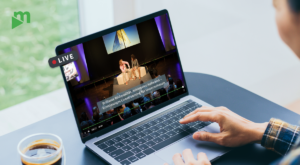What is transcoding and why does it matter to you?

Just to give you some numbers, research from Akamai says that “76% of viewers will also leave the service if their stream buffered several times”, while no re-buffers translate into a 20% increase in engagement from your audience.
Since the primary effect of transcoding is on the streaming quality of your videos, the answer is easy on this one: YES, it does matter to you. No matter what kind of business we are talking about.
In this article, we´ll try to make it easy and explain what kind of impact transcoding has on your video experience and the one of your users.

Simply said, transcoding improves the quality of your video-stream on any device and in any network condition. Thanks to this process, for instance, you are able to watch your favourite Series while traveling on a train.
But let´s take a step back and have a deeper look into the process. By transcoding, the file format, the audio, and the visual part of the video are converted from a format to another, for example obsolete data to a better video format but also to simply reduce the file size to match the platform of choice and the storage capacity of the end device used to play it, a TV, a smartphone, a computer or a tablet.
Therefore, transcoding includes transizing and transrating, being them the resizing of the video frame and the change of bitrate – the speed data are transferred with – respectively.
At the end of the process, the video file is ready to be played on any device of choice.
A buffer-free video experience
The main benefit of having a video transcoded, then, is to allow smooth and high-quality plays on any network conditions.
Today, it´s impossible to predict when and where your videos are going to be watched. Therefore, with adaptive bitrate streaming, you can always offer the right stream at the right time. Once the video is uploaded on the VideoManager Pro, it automatically transcodes to different formats and resolution, to be able to adapt itself to any bandwidth and deice. Hence. if the bandwidth changes, so does the file format.
So, for example, a viewer who is playing it under slow internet conditions, will be watching a lower resolution video, while a viewer with high-speed network will be playing the video in high-quality. Both users will be able to watch it without experiencing long buffering times, or any other interruptions.
In other words, the benefit of transcoded videos include:
- The chance to maximize the number of compatible playback devices
- The opportunity to make the encoded data accessible to a wider audience
The only thing your users will notice, is a buffer-free video experience.
The cooperation with Intel
The implementation of video naturally brings challenges. We help to overcome those challenges with our optimized hardware and software solutions.
Having video at the core of our business, we at movingimage are committed to enable our customers have the best video experience possible on our platform.
To make the transcoding of the videos uploaded on our platform even faster more efficient than before, at the beginning of 2022 we partnered with Intel.
The software engineers of Intel and movingimage worked side by side to achieve an impressive performance gain by doubling the speed of our video transcoding, at no additional cost. We are really satisfied with the results.
As a result, upon upload on VMPro your videos are transcoded to different file formats twice as fast as before. In the Video Formats section, the transcoding process to the following formats can be monitored.

You can therefore ensure a pleasurable, efficient, and professional viewing experience for your audience, from which the overall image of your brand will benefit.











